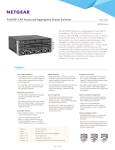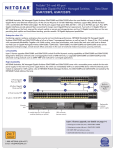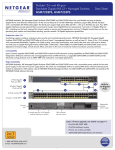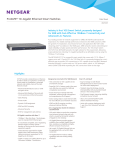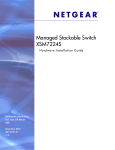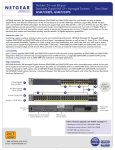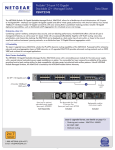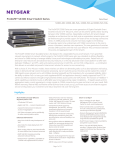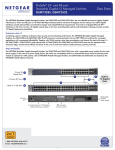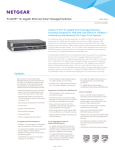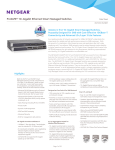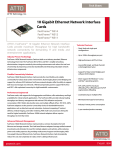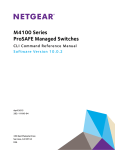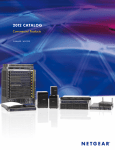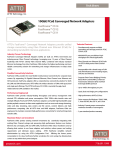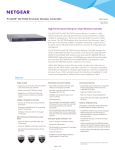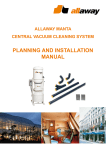Download Netgear XSM7224
Transcript
ProSafe® 10 Gigabit Managed Switches M7100 series Data Sheet The NETGEAR® 10 Gigabit M7100 series consists of a fully managed, low-latency, line-rate 10G Copper “Base-T” switch solution; 24 ports 10GBase-T (RJ45) that support Fast Ethernet, Gigabit Ethernet and 10 Gigabit speeds for server, storage and network progressive upgrade; 4 ports SFP+ that broaden 10 Gigabit connectivity for 1G/10G fiber uplinks and other DAC connections. The M7100 series is ideal for all organizations considering reliable, affordable and simple 10 Gigabit Ethernet Top-of-Rack server access layer and high-density, high-performance 10GbE backbone architectures. Layer 2+ with static routing •The M7100 series comes with Port-based/VLAN-based/Subnet-based “static routing” Layer 2+ versions •L3 fixed routes to the next hop towards the destination network are added to the routing table •L3 routing is wire-speed in the M7100 series hardware with up to 128 static routes (IPv4) 10 Gigabit transition with Base-T •10GBase-T, like other Base-T technologies, uses the standard RJ45 Ethernet jack •It is backward compatible, auto-negotiating between higher and lower speeds – thereby not forcing an all at once network equipment upgrade •Cat5/Cat5E are supported for Gigabit speeds; when Cat6 twisted pair copper cabling is a minimum requirement for 10 Gigabit up to 30 meters •Cat6A or newer Cat7 cabling allow for up to 100 meter 10GBase-T connections Top-of-the-line performance and IPv6 ready •32K MAC addresses; 480Gbps switching fabric; 12K jumbo frames; Auto-iSCSI Flow Acceleration; Auto-EEE Energy Efficient Ethernet •IPv4/IPv6 comprehensive traffic filtering (ACLs), and prioritization (QoS - DiffServ) Top-of-rack availability •Two redundant, hot-swap power supplies (one PSU comes with the switch; second optional PSU is ordered separately) •Two removable fan trays provide front-to-back cooling airflow for best compatibility with data center hot aisle/cold aisle airflow patterns Industry standard management •Industry standard command line interface (CLI) •Fully functional NETGEAR web interface (GUI) Industry leading warranty •The NETGEAR M7100 series is backed by a NETGEAR ProSafe Lifetime Hardware Warranty+ •Also included is the ProSupport Lifetime 24x7 Advanced Technical Support* •Also included is a 3-Year Next Business Day Onsite Hardware Replacement** Page 2 Models at a glance Page 3 Product brief Page 4-6 Modern access layer features highlights 24 / 7 TECHNICAL S U P P O R T* 1-888-NETGEAR (638-4327) Email: [email protected] -1- Page 7-8 Target application Page 9-10 Accessories & modules Page 11-23 Technical specifications and Ordering information ProSafe® 10 Gigabit Managed Switches M7100 series Hardware at a Glance FRONT Model name 100/1000/10GBase-T RJ45 ports 1000/10GBase-X Fiber SFP+ ports REAR Management console Storage (image, config) Modular PSUs (redundant, hot-swap) Modular Fan Trays (front-to-back cooling, hot-swap) 2 2 (Part-number: APS300W) (Part-number: AFT200) (1 power supply already installed) (2 fan trays already installed) 1 x RS232 DB9, M7100-24X 24 4 (shared) 1 x USB 1 x Mini-USB (selectable) Model number XSM7224 v1h1 M7100-24X is a 24 x 10Gbase-T version, Layer 2+ 4 shared SFP+ M7100 series rear view •2 modular, redundant PSUs ––Each M7100 series ships with one installed modular PSU ––Aditional PSU unit is available for hot swap HA (APS300W) •2 modular fan trays ––Each M7100 series ships with two installed fan trays ––Spare units are available for hot swap HA (AFT200) Software at a Glance LAYER 2+ PACKAGE Model name IPv4/IPv6 ACL and QoS IPv4/IPv6 Multicast filtering Auto-iSCSI Auto-VoIP EEE (802.3az) Auto-EEE VLANs Convergence M7100-24X L2, L3, L4, ingress, egress, 1 Kbps IGMP and MLD Snooping, Querier mode, MVR Yes Yes Static, Dynamic, Voice, MAC, Subnet, Protocol-based, QoQ, Private VLANs LLDP-MED, RADIUS, 802.1X, timer IPv4 Unicast Static Routing Yes (Port-based, Subnet, VLANs) Model number XSM7224 v1h1 Performance at a Glance TABLE SIZE Model name M7100-24X Packet buffer CPU 16 Mb 800Mhz 256M RAM 128M Flash ACLs 1K ingress 512 egress MAC address table ARP/NDP table VLANs DHCP server Fabric 32K MAC 6K ARP/NDP VLANs: 1K DHCP: 16 pools 1,024 max leases 480Gbps line-rate -2- Latency 10GBase-T <3.7 μs SFP+ <1.8 μs Static Routes Multicast IGMP Group membership sFlow Model number 128 IPv4 2K 32 samplers 52 pollers 8 receivers XSM7224 v1h1 ProSafe® 10 Gigabit Managed Switches M7100 series Product Brief The 10 Gigabit Aggregation M7100 series switches are NETGEAR affordable fully managed switches for 1G/10G server access layer in campus and enterprise networks, and for high-density, high-performance 10GbE backbone architectures. The M7100 series delivers pure line-rate performance for top-of-rack virtualization or convergence, without having to pay the exorbitant acquisition and maintenance costs associated by other networking vendors. NETGEAR 10 Gigabit Aggregation solutions combine latest advances in hardware and software engineering for higher availability, lower latency and stronger security, at a high-value price point. Like all NETGEAR products, the M7100 series delivers more functionality with less difficulty: Auto-iSCSI optimization, Private VLANs and Local Proxy ARP take the complexity out of delivering network services for virtualized servers and 10 Gigabit infrastructures. NETGEAR 10 Gigabit M7100 series key features: •Line-rate 10G Copper “Base-T” switch solution with low latency •24 ports 10GBase-T (RJ45) supporting Fast Ethernet, Gigabit Ethernet and 10 Gigabit speeds for server and network progressive upgrade •4 ports SFP+ for 1G/10G fiber uplinks and other DAC connections •IPv4 routing in Layer 2+ package (static routing) with IPv4/IPv6 ACLs and QoS •Enterprise-class L2/L3 tables with 32K MAC, 6K ARP/NDP, 1K VLANs, 128 static L3 routes •Two redundant, hot-swap power supplies (one PSU comes with the switch; second optional PSU is ordered separately) •Two removable fan trays and front-to-back cooling airflow for best compatibility with data center hot aisle/cold aisle airflow patterns •Auto-EEE Energy Efficient Ethernet associated with Power Back Off for 15% to 20% less consumption when short copper cables NETGEAR 10 Gigabit M7100 series software features: •Innovative multi-vendor Auto-iSCSI capabilities for easier virtualization optimization, iSCSI flow acceleration and automatic protection/QoS •Automatic multi-vendor Voice over IP prioritization based on SIP, H323 and SCCP protocol detection •Voice VLAN and LLDP-MED for automatic IP phones QoS and VLAN configuration •IPv4/IPv6 Multicast filtering with IGMP and MLD snooping, Querier mode and MVR for for simplified video deployments •Advanced classifier-based hardware implementation for L2 (MAC), L3 (IP) and L4 (UDP/TCP transport ports) security and prioritization •Unidirectional Link Detection Protocol (UDLD) prevents forwarding anomalies NETGEAR 10 Gigabit M7100 series link aggregation and channeling features: •Flexible Port-Channel/LAG (802.3ad) implementation for maximum compatibility, fault tolerance and load sharing with any type of Ethernet channeling •Including static (selectable hashing algorithms) or dynamic LAGs (LACP) •Multi-Chassis Link Aggregation (MLAG) in future maintenance release for active-active teaming across two independant M7100 series (Layer 2 LACP or STP) NETGEAR 10 Gigabit M7100 series management features: •DHCP/BootP innovative auto-installation including firmware and configuration file upload automation •Industry standard SNMP, RMON, MIB, LLDP, AAA and sFlow implementation •Selectable serial RS232 DB9 and Mini-USB port for management console •Standard USB port for local storage, logs, configuration or image files •Dual firmware image and configuration file for updates with minimum service interruption •Industry standard command line interface (CLI) for IT admins used to other vendors commands •Fully functional Web console (GUI) for IT admins who prefer an easy to use graphical interface NETGEAR 10 Gigabit M7100 series warranty and support: •NETGEAR ProSafe Lifetime Hardware Warranty† •Included ProSupport Lifetime 24x7 Advanced Technical Support* •Included 3-Year Next Business Day Onsite Hardware Replacement** -3- ProSafe® 10 Gigabit Managed Switches M7100 series Modern Access Layer Features Highlights Layer 3 hardware with L2+ software affordability M7100 series models are built upon L3 hardware platform while Layer 2+ software package allows for better budget optimization • M7100 series uses latest generation silicon low-power 65-nanometer technology M7100 series Layer 2+ software package provides straight forward IP static routing capabilities for physical interfaces, VLANs and subnets • M7100-24X • M7100 series L2 and L3 switching features (access control list, classification, filtering, IPv4 routing) are performed in hardware at interface line rate for voice, video, and data convergence • At the edge of campus networks or in the server room, static routes are often preferred for simplicity (L3 fixed routes to the next hop towards the destination network are manually added to the routing table), without any impact on performance because L3 routing is wire-speed in M7100 series hardware Top-of-the-line switching performance 32K MAC address table, 1K concurrent VLANs and 128 static routes for demanding enterprise and campus network access/distribution layers 80 PLUS certified power supplies for energy high efficiency Green Ethernet with Energy Efficient Ethernet (EEE) defined by IEEE 802.3az Energy Efficient Ethernet Task Force • Supports Auto-EEE mode • Additionally, Power Back Off feature drops power consumption by 15% to 20% when short copper cables are detected Increased packet buffering with up to 16 Mb dynamically shared accross all interfaces for most intensive virtualization applications Low latency at all network speeds, including 10 Gigabit Copper links Jumbo frames support of up to 12Kb accelerating storage performance for backup and cloud applications iSCSI Flow Acceleration and Automatic Protection/QoS for virtualization and server room networks containing iSCSI initiators and iSCSI targets by: • Detecting the establishment and termination of iSCSI sessions and connections by snooping packets used in the iSCSI protocol • Maintaining a database of currently active iSCSI sessions and connections to store data about the participants; this allows the formulation of classifier rules giving the data packets for the session the desired QoS treatment • Installing and removing classifier rule sets as needed for the iSCSI session traffic • Monitoring activity in the iSCSI sessions to allow for aging out session entries if the session termination packets are not received • Avoiding session interruptions during times of congestion that would otherwise cause iSCSI packets to be dropped Ease of deployment Automatic configuration with DHCP and BootP Auto Install eases large deployments with a scalable configuration files management capability, mapping IP addresses and host names and providing individual configuration files to multiple switches as soon as they are initialized on the network Both the Switch Serial Number and Switch primary MAC address are reported by a simple “show” command in the CLI - facilitating discovery and remote configuration operations Automatic Voice over IP prioritization with Auto-VoIP simplifies most complex multi-vendor IP telephones deployments either based on protocols (SIP, H323 and SCCP) or on OUI bytes (default database and user-based OUIs) in the phone source MAC address; providing the best class of service to VoIP streams (both data and signaling) over other ordinary traffic by classifying traffic, and enabling correct egress queue configuration An associated Voice VLAN can be easily configured with Auto-VoIP for further traffic isolation When deployed IP phones are LLDP-MED compliant, the Voice VLAN will use LLDP-MED to pass on the VLAN ID, 802.1P priority and DSCP values to the IP phones, accelerating convergent deployments Versatile connectivity Large 10 Gigabit choice for access with 10GBase-T ports for legacy Cat6 RJ45 short connections (up to 300m) and Cat6A/Cat 7 connections up to 100m; and SFP+ ports for fiber optic uplinks or short, low-latency copper DAC cables Automatic MDIX and Auto-negotiation on all ports select the right transmission modes (half or full duplex) as well as data transmission for crossover or straight-through cables dynamically 100Mbps and 1000Mbps backward compatiblity on all 10GBase-T RJ45 ports 1000Mbps backward compatibility on all SFP+ fiber ports IPv6 support with multicasting (MLD for IPv6 filtering), ACLs and QoS -4- ProSafe® 10 Gigabit Managed Switches M7100 series Modern Access Layer Features Highlights (continued) Tier 1 availability Multi-Chassis Link Aggregation (MLAG - future maintenance release) for distributed link aggregation across two independant switches • A server with two Ethernet ports (or any Ethernet device such as an edge switch) can use Ethernet chanelling or LACP bonding across two M7100 series • Active-active teaming across two separate fabrics at Layer 2 without creating loops • Load-balancing and automatic failover ensure greater bandwidth network layers and maximize redundancy Rapid Spanning Tree (RSTP) and Multiple Spanning Tree (MSTP) allow for rapid transitionning of the ports to the Forwarding state and the suppression of Topology Change Notification IP address conflict detection performed by the embedded DHCP server prevents accidental IP address duplicates from perturbing the overall network stability Power redundancy for higher availability when mission critical, including hot-swap PSUs and Fans Ease of management and control Dual firmware image and dual configuration file for transparent firmware updates/configuration changes with minimum service interruption Flexible Port-Channel/LAG (802.3ad) implementation for maximum compatibility, fault tolerance and load sharing with any type of Ethernet channeling from other vendors switch, server or storage devices conforming to IEEE 802.3ad - including static (selectable hashing algorithms) or dynamic LAGs (highly tunable LACP Link Aggregation Control Protocol) Unidirectional Link Detection Protocol (UDLD) and Aggressive UDLD detect and avoid unidirectional links automatically, in order to prevent forwarding anomalies in a Layer 2 communication channel in which a bi-directional link stops passing traffic in one direction Port names feature allows for descriptive names on all interfaces and better clarity in real word admin daily tasks SDM (System Data Management, or switch database) templates allow for granular system resources distribution depending on IPv4 or IPv6 applications: ARP Entries (the maximum number of entries in the IPv4 Address Resolution Protocol ARP cache for routing interfaces), IPv4 Unicast Routes (the maximum number of IPv4 unicast forwarding table entries), IPv6 NDP Entries (the maximum number of IPv6 Neighbor Discovery Protocol NDP cache entries), IPv6 Unicast Routes (the maximum number of IPv6 unicast forwarding table entries), ECMP Next Hops (the maximum number of next hops that can be installed in the IPv4 and IPv6 unicast forwarding tables), IPv4 Multicast Routes (the maximum number of IPv4 multicast forwarding table entries) and IPv6 Multicast Routes (the maximum number of IPv6 multicast forwarding table entries) Loopback interfaces management for routing protocols administration Private VLANs and local Proxy ARP help reduce broadcast with added security Management VLAN ID is user selectable for best convenience Industry-standard VLAN management in the command line interface (CLI) for all common operations such as VLAN creation; VLAN names; VLAN “make static” for dynamically created VLAN by GRVP registration; VLAN trunking; VLAN participation as well as VLAN ID (PVID) and VLAN tagging for one interface, a group of interfaces or all interfaces at once System defaults automatically set per-port broadcast, multicast, and unicast storm control for typical, robust protection against DoS attacks and faulty clients which can, with BYOD, often create network and performance issues IP Telephony administration is simplified with consistent Voice VLAN capabilities per the industry standards and automatic functions associated Comprehensive set of “system utilities” and “Clear” commands help troubleshoot connectivity issues and restore various configurations to their factory defaults for maximum admin efficiency: traceroute (to discover the routes that packets actually take when traveling on a hop-by-hop basis and with a synchronous response when initiated from the CLI), clear dynamically learned MAC addresses, counters, IGMP snooping table entries from the Multicast forwarding database etc... All major centralized software distribution platforms are supported for central software upgrades and configuration files management (HTTP, TFTP), including in highly secured versions (HTTPS, SFTP, SCP) Simple Network Time Protocol (SNTP) can be used to synchronize network resources and for adaptation of NTP, and can provide synchronized network timestamp either in broadcast or unicast mode (SNTP client implemented over UDP - port 123) Embedded RMON (4 groups) and sFlow agents permit external network traffic analysis Engineered for convergence Audio (Voice over IP) and Video (multicasting) comprehensive switching, filtering, routing and prioritization Auto-VoIP, Voice VLAN and LLDP-MED support for IP phones QoS and VLAN configuration IGMP Snooping for IPv4, MLD Snooping for IPv6 and Querier mode facilitate fast receivers joins and leaves for multicast streams and ensure multicast traffic only reaches interested receivers without the need of a Multicast router Multicast VLAN Registration (MVR) uses a dedicated Multicast VLAN to forward multicast streams and avoid duplication for clients in different VLANs Schedule enablement -5- ProSafe® 10 Gigabit Managed Switches M7100 series Modern Access Layer Features Highlights (continued) Enterprise security Traffic control MAC Filter and Port Security help restrict the traffic allowed into and out of specified ports or interfaces in the system in order to increase overall security and block MAC address flooding issues DHCP Snooping monitors DHCP traffic between DHCP clients and DHCP servers to filter harmful DHCP message and builds a bindings database of (MAC address, IP address, VLAN ID, port) tuples that are considered authorized in order to prevent DHCP server spoofing attacks IP Source Guard and Dynamic ARP Inspection use the DHCP snooping bindings database per port and per VLAN to drop incoming packets that do not match any binding and to enforce source IP/MAC addresses for malicious users traffic elimination Layer 2 / Layer 3-v4 / Layer 3-v6 / Layer 4 Access Control Lists (ACLs) can be binded to ports, Layer 2 interfaces, VLANs and LAGs (Link Aggregation Groups or Port channel) for fast unauthorized data prevention and right granularity ACLs on CPU interface (Control Plane ACLs) are used to define the IP/MAC or protocol through which management access is allowed for increased HTTP/HTTPS or Telnet/ SSH management security Bridge protocol data unit (BPDU) Guard allows the network administrator to enforce the Spanning Tree (STP) domain borders and keep the active topology consistent and predictable - unauthorized devices or switches behind the edge ports that have BPDU enabled will not be able to influence the overall STP topology by creating loops Spanning Tree Root Guard (STRG) enforces the Layer 2 network topology by preventing rogue root bridges potential issues when for instance, unauthorized or unexpected new equipment in the network may accidentally become a root bridge for a given VLAN Dynamic 802.1x VLAN assignment mode, including Dynamic VLAN creation mode and Guest VLAN/ Unauthenticated VLAN are supported for rigorous user and equipment RADIUS policy server enforcement •Up to 48 clients (802.1x) per port are supported, including the authentication of the users domain, in order to facilitate convergent deployments: for instance when IP phones connect PCs on their bridge, IP phones and PCs can authenticate on the same switch port but under different VLAN assignment policies (Voice VLAN versus data VLANs 802.1x MAC Address Authentication Bypass (MAB) is a: •A list of authorized MAC addresses of client NICs is maintained on the RADIUS server for MAB purpose •MAB can be configured on a per-port basis on the switch •MAB initiates only after the dot1x authentication process times out, and only when clients don’t respond to any of the EAPOL packets sent by the switch •When 802.1X unaware clients try to connect, the switch sends the MAC address of each client to the authentication server •The RADIUS server checks the MAC address of the client NIC against the list of authorized addresses •The RADIUS server returns the access policy and VLAN assignment to the switch for each client Double VLANs (DVLAN - QoQ) pass traffic from one customer domain to another through the “metro core” in a multi-tenancy environment:customer VLAN IDs are preserved and a service provider VLAN ID is added to the traffic so the traffic so the traffic can pass the metro core in a simple, secure manner Private VLANs (with Primary VLAN, Isolated VLAN, Community VLAN, Promiscuous port, Host port, Trunks) provide Layer 2 isolation between ports that share the same broadcast domain, allowing a VLAN broadcast domain to be partitioned into smaller pointto-multipoint subdomains accross switches in the same Layer 2 network •Private VLANs are useful in DMZ when servers are not supposed to communicate with each other but need to communicate with a router; they remove the need for more complex port-based VLANs with respective IP inter face/subnets and associated L3 routing •Another Private VLANs typical application are carrier-class deployments when users shouldn’t see, snoop or attack other users’ traffic Secure Shell (SSH) and SNMPv3 (with or without MD5 or SHA authentication) ensure SNMP and Telnet sessions are secure TACACS+ and RADIUS enhanced administrator management provides strict “Login” and “Enable” authentication enforcement for the switch configuration, based on latest industry standards: exec authorization using TACACS+ or RADIUS; command authorization using TACACS+ and RADIUS Server; user exec accounting for HTTP and HTTPS using TACACS+ or RADIUS; and authentication based on user domain in addition to user ID and password Superior quality of service Advanced classifier-based hardware implementation for Layer 2 (MAC), Layer 3 (IP) and Layer 4 (UDP/TCP transport ports) prioritization 8 queues for priorities and various QoS policies based on 802.1p (CoS) and DiffServ can be applied to interfaces and VLANs Advanced rate limiting down to 1 Kbps granularity and mininum-guaranteed bandwidth can be associated with ACLs for best granularity Automatic Voice over IP prioritization with Auto-VoIP iSCSI Flow Acceleration and automatic protection/QoS with Auto-iSCSI Flow Control 802.3x Flow Control implementation per IEEE 802.3 Annex 31 B specifications with Symmetric flow control, Asymmetric flow control or No flow control •Asymmetric flow control allows the switch to respond to received PAUSE frames, but the ports cannot generate PAUSE frames •Symmetric flow control allows the switch to both respond to, and generate MAC control PAUSE frames Allows traffic from one device to be throttled for a specified period of time: a device that wishes to inhibit transmission of data frames from another device on the LAN transmits a PAUSE frame UDLD Support UDLD implementation detects unidirectional links physical ports (UDLD must be enabled on both sides of the link in order to detect an unidirectional link) •UDLD protocol operates by exchanging packets containing information about neighboring devices •The purpose is to detect and avoid unidirectional link forwarding anomalies in a Layer 2 communication channel in which a bi-directional link stops passing traffic in one direction Both “normal-mode” and “aggressive-mode” are supported for perfect compatibility with other vendors implementations, including port “D-Disable” triggering cases in both modes -6- ProSafe® 10 Gigabit Managed Switches M7100 series Target Application Why 10 Gigabit Ethernet for edge or distribution of mid-sized networks? • The IEEE standard for 10 Gigabit Ethernet (10GbE), IEEE Standard 802 3ae - 2002, was ratified ten years ago. Almost immediately, large enterprises started confidently deploying 10GbE in their corporate backbones, data centers, and server farms to support high-bandwidth, mission- critical applications. • Over the years, improvements in 10GbE technology, price, and performance have extended its reach beyond enterprise data centers to mid-sized networks. Increasing bandwidth requirements and the growth of enterprise applications are also driving broader deployments of 10 Gigabit Ethernet. -7- ProSafe® 10 Gigabit Managed Switches M7100 series Target Application Three reasons to get started today with NETGEAR M7100 series 1 10 Gigabit Ethernet and the server edge: better efficiency Mid-sized organizations are optimizing their data centers and server rooms by consolidating servers to free up space, power, and management overhead. The first step usually involves consolidating applications onto fewer servers than the old single-application-perserver paradigm. Often, the next step is server virtualization. Server virtualization supports several applications and operating systems on a single sever by defining multiple virtual machines (VMs) on the server. Each virtual machine operates like a standalone, physical machine, yet shares the physical server processing power, ensuring no processing power is wasted. IT departments can reduce server inventory, better utilize servers, and manage resources more efficiently. Server virtualization relies heavily on networking and storage. Virtual machines grow and require larger amounts of storage than one physical server can provide. Network attached storage (NAS) or storage area networks (SANs) provide additional, dedicated storage for virtual machines. Connectivity between servers and storage must be fast to avoid bottlenecks. 10GbE provides the fastest interconnectivity for virtualized environments. 2 10 Gigabit Ethernet SAN versus Fibre Channel: simpler and more cost-effective There are three types of storage in a network: Direct-attached storage (DAS), NAS, and SAN. Each has its advantages, but SAN is emerging as the most flexible and scalable solution for data centers and high-density computing applications. The main drawback to SAN has been the expense and specially trained staff necessary for installing and maintaining the Fibre Channel (FC) interconnect fabric. Nonetheless, SANs with Fibre Channel have become well established in large enterprises. A new standard, the Internet Small Computer System Interface (iSCSI), is making 10 Gigabit Ethernet an attractive, alternative interconnect fabric for SAN applications. iSCSI is an extension of the SCSI protocol used for block transfers in most storage devices and Fibre Channel. The Internet extension defines protocols for extending block transfers over IP, allowing standard Ethernet infrastructure to be used as a SAN fabric. Basic iSCSI is supported in most operating systems today. The latest iSCSI capabilities allow 10 Gigabit Ethernet to compare very favorably to Fibre Channel as a SAN interconnect fabric: •Reduced equipment and management costs: 10GbE networking components are less expensive than highly specialized Fibre Channel components and do not require a specialized skill set for installation and management •Enhanced server management: iSCSI remote boot eliminates booting each server from its own direct-attached disk. Instead, servers can boot from an operating system image on the SAN. This is particularly advantageous for using diskless servers in rack-mount or blade server applications •Improved disaster recovery: all information on a local SAN — including boot information, operating system images, applications, and data — can be duplicated on a remote SAN for quick and complete disaster recovery •Excellent performance: even transactional virtual machines, such as databases, can run over 10 Gigabit Ethernet and iSCSI SAN, without compromising performance 3 10 Gigabit Ethernet and the aggregation layer: reduce bottlenecks Until recently, network design best practices recommended equipping the edge with Fast Ethernet (100Base-T), and using Gigabit uplinks to either the core (for two-tiered network architectures) or aggregation layer (for three-tiered networks). Today, traffic at the edge of the network has increased dramatically. Bandwidthintensive applications have multiplied, and Gigabit Ethernet to the desktop has become more popular as its price has decreased. Broader adoption of Gigabit Ethernet to the desktop has increased the oversubscription ratios of the rest of the network. The result: a bottleneck between large amounts of Gigabit traffic at the edge of the network, and the aggregation layer or core. 10 Gigabit Ethernet allows the aggregation layer to scale to meet the increasing demands of users and applications. It can help bring oversubscription ratios back in line with network-design best practices, and provides some important advantages over aggregating multiple Gigabit Ethernet links: •Less fiber usage: a 10 Gigabit Ethernet link uses fewer strands compared with Gigabit Ethernet aggregation, which uses one strand per Gigabit Ethernet link. Using 10 Gigabit Ethernet reduces cabling complexity and uses existing cabling efficiently •Greater support for large streams: traffic over aggregated 1Gigabit Ethernet links can be limited to 1 Gbps streams because of packet sequencing requirements on end devices. 10 Gigabit Ethernet can more effectively support applications that generate multi Gigabit streams due to the greater capacity in a single 10 Gigabit Ethernet link •Longer deployment lifetimes: 10 Gigabit Ethernet provides greater scalability than multiple Gigabit Ethernet links, resulting in a more future- proof network. Up to eight 10 Gigabit Ethernet links can be aggregated into a virtual 80-Gbps connection Conclusion For network connectivity, 10GBase-T, like other base-t technologies, uses the standard RJ45 Ethernet jack. This connection form factor is not only common on switches, but is also normally integrated onto servers, workstations and other PCs. Base-T usually runs up to a 100 meters, on the widely deployed, twisted pair copper cabling, such as Cat 6A type, and now more recently Cat 7 type. It is also backward compatible, auto-negotiating between higher and lower speeds – thereby not forcing an all at once network equipment upgrade. The NETGEAR M7100 series is the world-first realistic, cost-effective 10GBase-T departmental solution! -8- ProSafe® 10 Gigabit Managed Switches M7100 series Accessories and Modules Modular PSUs for M7100 series APS300W Modular Power Supply •PSU unit for M7100 series switches –– M7100-24X •Provides redundant power and hot swap replacement capability Ordering information • Worldwide: APS300W-10000S • Warranty: 5 years AFT200 Modular Fan Tray •Replaceable fan tray for M7100 series switches –– M7100-24X •Two fan trays (two fans each) are required for M7100 series Ordering information • Worldwide: AFT200-10000S • Warranty: 5 years GBIC SFP Optics for M7100 series Ordering information Worldwide: see table below Warranty: 5 years 10 Gigabit SFP+ Multimode Fiber (MMF) OM1 or OM2 62.5/125µm OM3 50/125µm Single mode Fiber (SMF) 9/125µm AXM763 AXM763 AXM762 10GBase-LRM long reach multimode 802.3aq - LC duplex connector 10GBase-LRM long reach multimode 802.3aq - LC duplex connector 10GBase-LR long reach single mode LC duplex connector up to 220m (722 ft) up to 260m (853 ft) up to 10km (6.2 miles) AXM763-10000S (1 unit) AXM763-10000S (1 unit) AXM762-10000S (1 unit) AXM762P10-10000S (pack of 10 units) AXM761 10GBase-SR short reach multimode LC duplex connector up to 300m (984 ft) •Fits into M7100 series shared SFP+ interfaces AXM761-10000S (1 unit) AXM761P10-10000S (pack of 10 units) Gigabit SFP AGM731F AGM731F AGM732F 1000Base-SX short range multimode LC duplex connector 1000Base-SX short range multimode LC duplex connector 1000Base-LX long range single mode LC duplex connector up to 275m (902 ft) up to 550m (1,804 ft) up to 10km (6.2 miles)) AGM731F (1 unit) AGM731F (1 unit) AGM732F (1 unit) •Fits into M7100 series shared SFP+ interfaces -9- ProSafe® 10 Gigabit Managed Switches M7100 series Accessories and Modules Direct Attach Cables for M5300 series SFP+ to SFP+ Ordering information Worldwide: see table below Warranty: 5 years 10 Gigabit DAC SFP+ to XFP 1 meter (3.3 ft) 3 meters (9.8 ft) 3 meters (9.8 ft) AXC761 AXC763 AXC753 10GSFP+ Cu (passive) SFP+ connectors on both end 10GSFP+ Cu (passive) SFP+ connectors on both end 10GSFP+ Cu (passive) one SFP+ connector one XFP connector AXC761-10000S (1 unit) AXC763-10000S (1 unit) AXC753-10000S (1 unit) •Fits into M7100 series shared SFP+ interfaces - 10 - ProSafe® 10 Gigabit Managed Switches M7100 series Technical Specifications •Requirements based on 10.x unified software release Model Name Description Model number M7100-24X 24 ports 10GBase-T, Layer 2+ software package XSM7224 v1h1 TECHNICAL SPECIFICATIONS PHYSICAL INTERFACES Front Auto-sensing RJ45 100/1000/10GBase-T Auto-sensing SFP+ ports 1000/10GBase-X Storage port Console ports 24 4 1 x USB Serial RS232 DB9, Mini-USB (selectable) M7100-24X Rear Modular PSUs Modular Fan Trays 2 2 M7100-24X Total Port Count M7100-24X M7100 series comes with one PSU, and two fan trays already installed 10 Gigabit 24 PROCESSOR/MEMORY Processor (CPU) Freescale P1011 800Mhz (45nm technology) System memory (RAM) 256 MB Code storage (flash) 128 MB Dual firmware image, dual configuration file 16 Mb Dynamically shared across only used ports 480 Gbps Line-rate (non blocking fabric) Packet Buffer Memory M7100-24X PERFORMANCE SUMMARY Switching fabric M7100-24X Throughput M7100-24X 357.1 Mpps Green Ethernet IEEE 802.3az Energy Efficient Ethernet Task Force compliance Deactivated by default Auto-EEE Mode Yes Deactivated by default Power Back Off Drops power consumption by 15% to 20% when short copper cables are detected 10GBase-T standard Energy Efficient Ethernet (EEE) Other Metrics Forwarding mode Store-and-forward Latency (64-byte frames, 100 Mbps, Copper) <8.5 μs Latency (64-byte frames, 1 Gbps, Copper) <2.8 μs Latency (64-byte frames, 1 Gbps, Fiber SFP) <2.5 μs Latency (64-byte frames, 10 Gbps, Copper 10GBase-T) <3.7 μs Latency (64-byte frames, 10 Gbps, Fiber SFP+) <1.8 μs Addressing 48-bit MAC address - 11 - ProSafe® 10 Gigabit Managed Switches Address database size Number of VLANs M7100 series 32,000 MAC addresses 1,024 VLANs (802.1Q) simultaneously Number of multicast groups filtered (IGMP) Number of Link Aggregation Groups (LAGs - 802.3ad) 2K 12 LAGs with up to 8 ports per group Number of hardware queues for QoS 8 queues Number of routes IPv4 128 Number of IP interfaces (port or VLAN) 128 Jumbo frame support Acoustic noise (ANSI-S10.12) up to 12K packet size @ 25 °C ambient (77 °F) M7100-24X <60 dB Fan speed control Heat Dissipation (BTU) M7100-24X Mean Time Between Failures (MTBF) M7100-24X 587 Btu/hr @ 25 °C ambient (77 °F) @ 55 °C ambient (131 °F) 172,955 hours (~19.7 years) 35,725 hours (~4.1 years) L2 SERVICES - VLANS IEEE 802.1Q VLAN Tagging Yes Protocol Based VLANs IP subnet ARP IPX Yes Yes Yes Yes Subnet based VLANs Yes MAC based VLANs Yes Voice VLAN Yes Private Edge VLAN Yes Private VLAN Yes IEEE 802.1x Guest VLAN RADIUS based VLAN assignment via .1x RADIUS based Filter ID assignment via .1x MAC-based .1x Unauthenticated VLAN Yes Yes Yes Yes Yes Yes Double VLAN Tagging (QoQ) Enabling dvlan-tunnel makes interface Global ethertype (TPID) Interface ethertype (TPID) Customer ID using PVID Yes Yes Yes Yes Yes GARP with GVRP/GMRP Yes MVR (Multicast VLAN registration) Yes Up to 1,024 VLANs - 802.1Q Tagging IP phones and PCs can authenticate on the same port but under different VLAN assignment policies Automatic registration for membership in VLANs or in multicast groups L2 SERVICES - AVAILABILITY IEEE 802.3ad - LAGs LACP Static LAGs Yes Yes Yes LAG Hashing Yes Storm Control Yes IEEE 802.3x (Full Duplex and flow control) Per port Flow Control Yes Yes - 12 - Up to 24 LAGs and up to 8 physical ports per LAG Asymmetric and Symmetric Flow Control ProSafe® 10 Gigabit Managed Switches M7100 series UDLD Support (Unidirectional Link Detection) Normal-Mode Aggressive-Mode Yes Yes Yes Yes IEEE 802.1D Spanning Tree Protocol Yes IEEE 802.1w Rapid Spanning Tree Yes IEEE 802.1s Multiple Spanning Tree Yes STP Loop Guard Yes STP Root Guard Yes BPDU Guard Yes L2 SERVICES - MULTICAST FILTERING IGMPv2 Snooping Support Yes IGMPv3 Snooping Support Yes MLDv1 Snooping Support Yes MLDv2 Snooping Support Yes Expedited Leave function Yes Static L2 Multicast Filtering Yes IGMP Snooping Enable IGMP Snooping per VLAN Snooping Querier Yes Yes Yes Multicast VLAN registration (MVR) Yes L3 SERVICES - DHCP DHCP IPv4/DHCP IPv6 Client Yes DHCP IPv4 Server Yes DHCP Snooping IPv4 Yes DHCP Relay IPv4 Yes DHCP BootP IPv4 Yes Auto Install (DHCP options 66, 67, 150) Yes L3 SERVICES - IPV4 ROUTING Static Routing Yes Port Based Routing Yes VLAN Routing 802.3ad (LAG) for router ports Yes Yes IP Helper Max IP Helper entries Yes 512 IP Source Guard Yes ECMP Yes Proxy ARP Yes Multinetting Yes ICMP redirect detection in hardware Yes DNSv4 Yes ICMP throttling Yes - 13 - ProSafe® 10 Gigabit Managed Switches M7100 series NETWORK MONITORING AND DISCOVERY SERVICES ISDP (Industry Standard Discovery Protocol) Yes 802.1ab LLDP Yes 802.1ab LLDP - MED Yes SNMP inter-operates with devices running CDP V1, V2, V3 RMON 1,2,3,9 Yes sFlow Yes SECURITY Network Storm Protection, DoS Broadcast, Unicast, Multicast DoS Protection Denial of Service Protection (control plane) Denial of Service Protection (data plane) DoS attacks Yes Yes Yes Switch CPU protection Switch Traffic protection SIPDIP UDPPORT L4PORT SMACDMAC TCPFLAGSEQ ICMPV4 FIRSTFRAG TCPOFFSET ICMPV6 TCPFRAG TCPSYN ICMPFRAG TCPFLAG TCPSYNFIN I TCPPORT TCPFINURGPSH Yes Restrict ICMP, PING traffic for ICMP-based DoS attacks Management ACL (MACAL) Max Rules Yes 64 Protects management CPU access through the LAN Radius accounting Yes RFC 2565 and RFC 2866 TACACS+ Yes ICMP throttling Management Network Traffic Access Control Lists (ACLs) L2 / L3 / L4 MAC, IPv4, IPv6, TCP, UDP Protocol-based ACLs Yes ACL over VLANs Yes Dynamic ACLs Yes IEEE 802.1x Radius Port Access Authentication Yes Up to 48 clients (802.1x) per port are supported, including the authentication of the users domain 802.1x MAC Address Authentication Bypass (MAB) Yes Supplemental authentication mechanism for non802.1x devices, based on their MAC address only Port Security Yes IP Source Guard Yes DHCP Snooping Yes Dynamic ARP Inspection Yes MAC Filtering Yes Port MAC Locking Yes Private Edge VLAN Yes A protected port doesn’t forward any traffic (unicast, multicast, or broadcast) to any other protected port - same switch Private VLANs Yes Scales Private Edge VLANs by providing Layer 2 isolation between ports accross switches in same Layer 2 network - 14 - ProSafe® 10 Gigabit Managed Switches M7100 series QUALITY OF SERVICE (QOS) - SUMMARY Access Lists L2 MAC, L3 IP and L4 Port ACLs Ingress Egress 802.3ad (LAG) for ACL assignment Binding ACLs to VLANs ACL Logging Support for IPv6 fields Yes Yes Yes Yes Yes Yes Yes DiffServ QoS Edge Node applicability Interior Node applicability 802.3ad (LAG) for service interface Support for IPv6 fields Ingress/Egress Yes Yes Yes Yes Yes Yes IEEE 802.1p COS 802.3ad (LAG) for COS configuration WRED (Weighted Deficit Round Robin) Strict Priority queue technology Yes Yes Yes Yes Auto-VoIP iSCSI Flow Acceleration Dot1p Marking IP DSCP Marking Yes, based on protocols (SIP, H323 and SCCP) or on OUI bytes (default database and user-based OUIs) in the phone source MAC address Yes Yes Yes QOS - ACL FEATURE SUPPORT ACL Support (include L3 IP and L4 TCP/UDP) Yes MAC ACL Support Yes IP Rule Match Fields Dest IP Dest IPv6 IP Dest L4 Port Every Packet IP DSCP IP Precedence IP TOS Protocol Source IP (for Mask support see below) Source IPv6 IP L3 IPv6 Flow Label Source L4 Port Supports Masking Inbound/Outbound Inbound/Outbound Inbound/Outbound Inbound/Outbound Inbound/Outbound Inbound/Outbound Inbound/Outbound Inbound/Outbound Inbound/Outbound Inbound/Outbound Inbound Inbound/Outbound Inbound/Outbound MAC Rule Match Fields COS Dest MAC Dest MAC Mask Ethertype Source MAC Source MAC Mask VLAN ID VLAN ID2 (Secondary VLAN) Inbound/Outbound Inbound/Outbound Inbound/Outbound Inbound/Outbound Inbound/Outbound Inbound/Outbound Inbound/Outbound Yes Rules Attributes Assign Queue Logging – deny rules Mirror (to supported interface types only) Redirect (to supported interface types only) Inbound Inbound/Outbound Inbound Inbound Interface Inbound direction Outbound direction Supports LAG interfaces Multiple ACLs per interface, dir Mixed-type ACLs per interface, dir Mixed L2/IPv4 ACLs per interface, inbound Mixed IPv4/IPv6 ACLs per interface, inbound Mixed IPv4/IPv6 ACLs per interface, outbound) Yes Yes Yes Yes Yes Yes Yes Yes - 15 - ProSafe® 10 Gigabit Managed Switches M7100 series QOS - DIFFSERV FEATURE SUPPORT DiffServ Supported Yes Class Type All Yes Class Match Criteria COS COS2 (Secondary COS) Dest IP (for Mask support see below) Dest IPv6 IP Dest L4 Port Dest MAC (for Mask support see below) Ethertype Every Packet IP DSCP IP Precedence IP TOS (for Mask support see below) Protocol Reference Class Source IP (for Mask support see below) Source IPv6 IP L3 IPv6 Flow Label Source L4 Port Source MAC (for Mask support see below) VLAN ID (Source VID) VLAN ID2 (Secondary VLAN) (Source VID) Supports Masking Policy Out Class Unrestricted Inbound/Outbound Inbound Inbound/Outbound Inbound/Outbound Inbound/Outbound Inbound/Outbound Inbound/Outbound Inbound/Outbound Inbound/Outbound Inbound/Outbound Inbound/Outbound Inbound/Outbound Inbound/Outbound Inbound/Outbound Inbound/Outbound Inbound Inbound/Outbound Inbound/Outbound Inbound/Outbound Inbound/Outbound Inbound/Outbound Yes Policy Attributes – Inbound Assign Queue Drop Mark COS Mark IP DSCP Mark IP Precedence Mirror (to supported interface types only) Police Simple Police Color Aware Mode Inbound Yes Yes Yes Yes Inbound Yes Yes Policy Attributes – Outbound Drop Mark COS Mark IP DSCP Mark IP Precedence Police Simple Police Color Aware Mode Redirect (to supported interface types only) Yes Yes Yes Yes Yes Yes Yes Inbound Service Interface Inbound Slot.Port configurable Inbound ‘All’ Ports configurable Outbound Slot.Port configurable Outbound ‘All’ Ports configurable Supports LAG interfaces Mixed L2/IPv4 match criteria, inbound Mixed IPv4/IPv6 match criteria, inbound Mixed IPv4/IPv6 match criteria, outbound Yes Yes Yes Yes Yes Yes Yes Yes PHB Support EF AF4x AF3x AF2x AF1x CS Yes Yes Yes Yes Yes Yes Statistics – Policy Instance Offered Discarded packets packets - 16 - ProSafe® 10 Gigabit Managed Switches M7100 series QOS - COS FEATURE SUPPORT COS Support Supports LAG interfaces COS Mapping Config Yes Yes Yes Configurable per-interface IP DSCP Mapping Yes Yes COS Queue Config Queue Parms configurable per-interface Drop Parms configurable per-interface Interface Traffic Shaping (for whole egress interface) Minimum Bandwidth Weighted Deficit Round Robin (WDRR) Support Maximum Queue Weight WRED Support Yes Yes Yes Yes Yes 127 Yes IEEE NETWORK PROTOCOLS IEEE 802.3 Ethernet IEEE 802.3u 100BASE-T IEEE 802.3ab 1000BASE-T IEEE 802.3z Gigabit Ethernet 1000BASE-SX/LX IEEE 802.3ae 10-Gigabit Ethernet IEEE 802.1D Spanning Tree (STP) IEEE 802.1Q VLAN tagging IEEE 802.3az Energy Efficient Ethernet IEEE 802.1s Multiple Spanning Tree (MSTP) IEEE 802.1v Protocol-based VLAN IEEE 802.3ad Trunking (LACP) IEEE 802.1w Rapid Spanning Tree (RSTP) IEEE 802.1p Quality of Service IEEE 802.1X Radius network access control IEEE 802.3x Flow control IEEE 802.1AB LLDP with ANSI/TIA-1057 (LLDP-MED) IETF RFC STANDARDS AND MIBS System Facilities RFC 768 – UDP RFC 2131 – DHCP Client/Server RFC 783 – TFTP RFC 2132 – DHCP options & BOOTP vendor extensions RFC 791 – IP RFC 2030 – Simple Network Time Protocol (SNTP) Version 4 for IPv4, IPv6 and OSI RFC 792 – ICMP RFC 2865 – RADIUS Client (both Switch and Management access) RFC 793 – TCP RFC 2866 – RADIUS Accounting RFC 826 – Ethernet ARP RFC 2868 – RADIUS Attributes for Tunnel Protocol support RFC 894 – Transmission of IP datagrams over Ethernet networks RFC 2869 – RADIUS Extensions RFC 896 – Congestion control in IP/TCP Networks RFC2869bis – RADIUS Support for Extensible Authentication Protocol (EAP) RFC 951 – BOOTP RFC 3164 – The BSD Syslog Protocol RFC 1321 – Message-digest algorithm RFC 3580 – 802.1X RADIUS usage guidelines (VLAN assignment via RADIUS, dynamic VLAN) RFC 1534 – Interoperation between BOOTP and DHCP Switching MIB RFC 1213 – MIB-II RFC 2620 – RADIUS Accounting MIB RFC 1493 – Bridge MIB RFC 2737 – Entity MIB version 2 RFC 1643 – Ethernet-like MIB RFC 2819 – RMON Groups 1,2,3 & 9 RFC 2233 – The Interfaces Group MIB using SMI v2 IEEE 802.1X MIB (IEEE 802.1-PAE-MIB 2004 Revision) RFC 2674 – VLAN MIB IEEE 802.1AB – LLDP MIB RFC 2613 – SMON MIB ANSI/TIA 1057 – LLDP-MED MIB RFC 2618 – RADIUS Authentication Client MIB Private Enterprise MIBs supporting switching features IPv4 Routing RFC 1027 – Using ARP to implement transparent subnet Gateways (Proxy ARP) RFC 2131 – DHCP relay RFC 1256 – ICMP Router Discovery Messages Layer 3 software package required RFC 3046 – DHCP Relay Agent Information option - 17 - ProSafe® 10 Gigabit Managed Switches RFC 1812 – Requirements for IP Version 4 routers M7100 series VLAN routing IPv4 Routing MIB RFC 2096 – IP Forwarding Table MIB Private enterprise MIB supporting routing features Multicast RFC 1112 – Host extensions for IP Multicasting RFC 2710 – Multicast Listener Discovery (MLD) for IPv6 RFC 2236 – Internet Group Management Protocol, Version 2 RFC 3376 – Internet Group Management Protocol, Version 3 RFC 2365 – Administratively Scoped IP Multicast RFC 3810 – Multicast Listener Discovery Version 2 (MLDv2) for IPv6 Multicast MIB Draft-ietf-magma-mgmd-mib-05 Multicast Group Membership Discovery MIB Private Enterprise MIB supporting Multicast features IPv6 Routing RFC 1981 – Path MTU for IPv6 RFC 3484 – Default Address Selection for IPv6 RFC 2460 – IPv6 Protocol specification RFC 3493 – Basic Socket Interface for IPv6 RFC 2461 – Neighbor Discovery RFC 3542 – Advanced Sockets API for IPv6 RFC 2462 – Stateless Auto Configuration RFC 3587 – IPv6 Global Unicast Address Format RFC 2464 – IPv6 over Ethernet RFC 3736 – Stateless DHCPv6 IPv6 Routing MB RFC 2465 – IPv6 MIB RFC 2466 – ICMPv6 MIB QoS RFC 2474 – Definition of Differentiated Services Field (DS Field) in the IPv4 and IPv6 Headers RFC 3260 – New Terminology and Clarifications for DiffServ RFC 2475 – An Architecture for Differentiated Services RFC 3289 – Management Information Base for the Differentiated Services Architecture (read-only) RFC 2597 – Assured Forwarding PHB Group RFC 3246 – An Expedited Forwarding PHB (Per-Hop Behavior) Private MIBs for full configuration of DiffServ, ACL and CoS functionality Management RFC 854 – Telnet RFC 3412 – Message Processing & Dispatching RFC 855 – Telnet Option RFC 3413 – SNMP Applications RFC 1155 – SMI v1 RFC 3414 – User-Based Security Model RFC 1157 – SNMP RFC 3415 – View-based Access Control Model RFC 1212 – Concise MIB Definitions RFC 3416 – Version 2 of SNMP Protocol Operations RFC 1867 – HTML/2.0 Forms with file upload extensions RFC 3417 – Transport Mappings RFC 1901 – Community-based SNMP v2 RFC 3418 – Management Information Base (MIB) for the Simple Network Management Protocol (SNMP) RFC 1908 – Coexistence between SNMP v1 & SNMP v2 RFC 2068 – HTTP/1.1 protocol as updated by draftietf-http-v11-spec-rev-03 RFC 2271 – SNMP Framework MIB SSL 3.0 and TLS 1.0 - RFC 2246 – The TLS Protocol, Version 1.0 - RFC 2818 – HTTP over TLS - RFC 2346 – AES Ciphersuites for Transport Layer Security RFC 2295 – Transparent Content Negotiation - 18 - ProSafe® 10 Gigabit Managed Switches M7100 series RFC 2296 – Remote Variant Selection; RSVA/1.0 State Management “cookies” – draft-ietf-http-state-mgmt-05 RFC 2576 – Coexistence between SNMP v1, v2 and v3 RFC 2578 – SMI v2 RFC 2579 – Textual Conventions for SMI v2 RFC 2580 – Conformance statements for SMI v2 RFC 3410 – Introduction and Applicability Statements for Internet Standard Management Framework SSH 1.5 and 2.0 - RFC 4253 – SSH Transport Layer Protocol - RFC 4252 – SSH Authentication Protocol - RFC 4254 – SSH Connection Protocol - RFC 4251 – SSH Protocol Architecture - RFC 4716 – SECSH Public Key File Format - RFC 4419 – Diffie-Hellman Group Exchange for the SSH Transport Layer Protocol RFC 3411 – An Architecture for Describing SNMP Management Frameworks MANAGEMENT Password management Yes Configurable Management VLAN Yes Auto Install (BOOTP and DHCP options 66, 67, 150 and 55, 125) Yes Scalable deployment process (firmware, config) Admin access control via Radius and TACACS+ Yes Policies, Enable Industry standard CLI (IS-CLI) Yes Command Line interface CLI commands logged to a Syslog server Yes Web-based graphical user interface (GUI) Yes Telnet Yes IPv6 management Yes Dual Software (firmware) image Yes Allows non disruptive firmware upgrade process Dual Configuration file Yes Text-based (CLI commands) configuration file IS-CLI Scripting Yes Industry standard CLI commands scripts for automation Port descriptions Yes SNTP client over UDP port 123 Yes XMODEM Yes SNMP v1/v2 Yes SNMP v3 with multiple IP addresses Yes RMON 1,2,3,9 Max History entries Max buckets per History entry Max Alarm entries Max Event entries Max Log entries per Event entry Yes 3 * (number of ports in the stack + LAG + 10) 10 3 * (number of ports in the stack + LAG + 10) 3 * (number of ports in the stack + LAG + 10) 10 Port Mirroring Number of monitor sessions Tx/Rx Many to One Port Mirroring LAG supported as source ports Max source ports in a session Yes 1 Yes Yes Yes Total switch port count Flow based mirroring Yes Cable Test utility Yes Traceroute feature Yes Outbound Telnet Yes SSH SSH Session Configuration v1/v2 Yes - 19 - Fully functional GUI Provides synchronized network timestamp either in broadcast or unicast mode CLI, Web GUI Secure Shell ProSafe® 10 Gigabit Managed Switches SSL/HTTPS and TLS v1.0 for web-based access M7100 series Yes File transfers (uploads, downloads) TFTP/HTTP Secured protocols for file transfers SCP/SFTP/HTTPS HTTP Max Sessions 16 SSL/HTTPS Max Sessions 16 HTTP Download (firmware) Yes Syslog (RFC 3164) Yes Persistent log supported Yes USER ADMIN MANAGEMENT User ID configuration Max number of configured users Support multiple READWRITE Users Max number of IAS users (internal user database) Yes 6 Yes 100 Authentication login lists Yes Authentication Enable lists Yes Authentication HTTP lists Yes Authentication HTTPS lists Yes Authentication Dot1x lists Yes Accounting Exec lists Yes Accounting Commands lists Yes Login History 50 M7100 SERIES - PLATFORM CONSTANTS Maximum number of remote Telnet connections 5 Maximum number of remote SSH connections 5 Number of MAC Addresses 32K Number of VLANs 1K VLAN ID Range 1 - 4093 Number of 802.1p Traffic Classes 8 classes IEEE 802.1x Number of .1x clients per port 48 Number of LAGs 12 LAGs with up to 8 ports per group Maximum multiple spanning tree instances 32 MAC based VLANS Number supported Yes 256 Number of log messages buffered 200 Static filter entries Unicast MAC and source port Multicast MAC and source port Multicast MAC and destination port (only) 20 20 256 Subnet based VLANs Number supported Yes 128 Protocol Based VLANs Max number of groups Max protocols Yes 128 16 - 20 - ProSafe® 10 Gigabit Managed Switches M7100 series Maximum Multicast MAC Addresses entries 2K Jumbo Frame Support Max Size Supported Yes 12k Number of DHCP snooping bindings 32K Number of DHCP snooping static entries 1024 LLDP-MED number of remote nodes Port MAC Locking Dynamic addresses per port Static addresses per port 48 Yes 4096 48 sFlow Number of samplers Number of pollers Number of receivers 32 52 8 Radius Max Authentication servers Max Accounting servers 5 1 Number of routing interfaces (including port/vlan) 128 Number of static routes (v4) 128 Routing Heap size IPv4 26M DHCP Server Max number of pools Total max leases 16 1024 DNS Client Concurrent requests Name server entries Seach list entries Static host entries Cache entries Domain search list entries 16 8 6 64 128 32 Number of Host Entries (ARP/NDP) IPv4 build Static v4 ARP Entries 6K 128 Number of ECMP Next Hops per Route ACL Limits Maximum Number of ACLs (any type) Maximum Number Configurable Rules per List Maximum ACL Rules per Interface and Direction (IPv4/L2) Maximum ACL Rules per Interface and Direction (IPv6) Maximum ACL Rules (system-wide) Maximum ACL Logging Rules (system-wide) COS Device Characteristics Configurable Queues per Port Configurable Drop Precedence Levels DiffServ Device Limits Number of Queues Requires TLV to contain all policy instances combined Max Rules per Class Max Instances per Policy Max Attributes per Instance Max Service Interfaces Max Table Entries Class Table Class Rule Table Policy Table Policy Instance Table Policy Attribute Table Max Nested Class Chain Rule Count AutoVoIP number of voice calls 4 100 1023 ingress/512 egress 1023 ingress/511 egress 509 ingress/255 egress 16384 128 8 queues 3 8 queues Yes 13 28 3 58 interfaces 32 192 64 640 1920 26 16 - 21 - ProSafe® 10 Gigabit Managed Switches iSCSI Flow Acceleration Max Monitored TCP Ports/IP Addresses Max Sessions Max Connections M7100 series 16 192 192 LED Per port Per device Speed, Link, Activity Power supply 1, Power supply 2, Fan trays status PHYSICAL SPECIFICATIONS Dimensions Weight M7100-24X 440 x 430 x 44 mm (17.32 x 16.93 x 1.73 in) 6.984 kg (15.40 lb) POWER CONSUMPTION Worst case, all ports used, line-rate traffic M7100-24X 200W (90VAC@47Hz) max ENVIRONMENTAL SPECIFICATIONS Operating: Temperature Humidity Altitude 32° to 122°F (0° to 50°C) 90% maximum relative humidity, non-condensing 10,000 ft (3,000 m) maximum Storage: Temperature Humidity Altitude – 4° to 158°F (–20° to 70°C) 95% maximum relative humidity, non-condensing 10,000 ft (3,000 m) maximum ELECTROMAGNETIC EMISSIONS AND IMMUNITY Certifications CE mark, commercial FCC Part 15 Class A, VCCI Class A Class A EN 55022 (CISPR 22) Class A Class A C-Tick EN 50082-1 EN 55024 SAFETY Certifications CE mark, commercial CSA certified (CSA 22.2 #950) UL listed (UL 1950)/cUL IEC 950/EN 60950 PACKAGE CONTENT All models ProSafe® M7100 series switch equipped with 1 x PSU and 2 x Fan trays Power cord Rubber footpads for tabletop installation Rubber caps for the SFP+ sockets Rack-mounting kit Mini-USB to USB cable for console Resource CD with links to online documentation, installation guides, USB drivers, software manual, CLI admin guide, Web GUI guide OPTIONAL MODULES AND ACCESSORIES All models: Ordering SKU: AGM731F 1000Base-SX SFP GBIC (Multimode) AGM731F AGM732F 1000Base-LX SFP GBIC (Single mode) AGM732F AXC761 10GSFP+ Cu (passive) SFP+ to SFP+ Direct Attach Cable 1m AXC761-10000S AXC763 10GSFP+ Cu (passive) SFP+ to SFP+ Direct Attach Cable 3m AXC763 -10000S AXC753 10GSFP+ Cu (passive) SFP+ to XFP Direct Attach Cable 3m AXC753-10000S AXM761 10GBase-SR SFP+ GBIC (OM3 Multimode) AXM761-10000S AXM761 (Pack of 10 units) 10GBase-SR SFP+ GBIC (OM3 Multimode) AXM761P10-10000S - 22 - ProSafe® 10 Gigabit Managed Switches M7100 series AXM762 10GBase-LR SFP+ GBIC (Single mode) AXM762-10000S AXM762 (Pack of 10 units) 10GBase-LR SFP+ GBIC (Single mode) AXM762P10-10000S AXM763 10GBase-LRM SFP+ GBIC (Long Reach Multimode, OM1, OM2 or OM3) AXM763-10000S APS300W Modular Power Supply APS300W-10000S AFT200 Modular Fan Tray AFT200-10000S M7100-24X WARRANTY AND SUPPORT ProSafe Lifetime Warranty† Included, lifetime ProSupport Lifetime 24x7 Advanced Technical Support* Included, lifetime Next Business Day onsite hardware replacement support** Included, 3 years PROSUPPORT SERVICE PACKS 3-year Next Business Day hardware replacement contract (applicable where next business day onsite hardware replacement is not available) M7100-24X XPressHW, Category 4 PRR0334 service contract ORDERING INFORMATION M7100-24X Americas, Europe Asia Pacific China 350 E. Plumeria Drive San Jose, CA 95134-1911 USA 1-888-NETGEAR (638-4327) E-mail: [email protected] www.NETGEAR.com XSM7224-100NES XSM7224-100AJS XSM7224-100PRS V1H1 V1H1 V1H1 © 2012 NETGEAR, Inc. NETGEAR, the NETGEAR Logo, Connect with Innovation, and ProSafe are trademarks and/or registered trademarks of NETGEAR, Inc. and/or subsidiaries in the United States and/or other countries. Other brand names mentioned herein are for identification purposes only and may be trademarks of their respective holder (s). Information is subject to change without notice. All rights reserved. † 24x7 Lifetime Advanced Technical Support includes Remote Diagnostics performed by our technical experts for prompt resolution of technical issues. ** 3-year Next business day onsite hardware replacement support included: see http://onsite.netgear.com for coverage, availability and terms and conditions. + Lifetime warranty for product purchased after 05/01/2007. For product purchased before 05/01/2007, warranty is 5 years. DS-M7100-1 - 23 -























